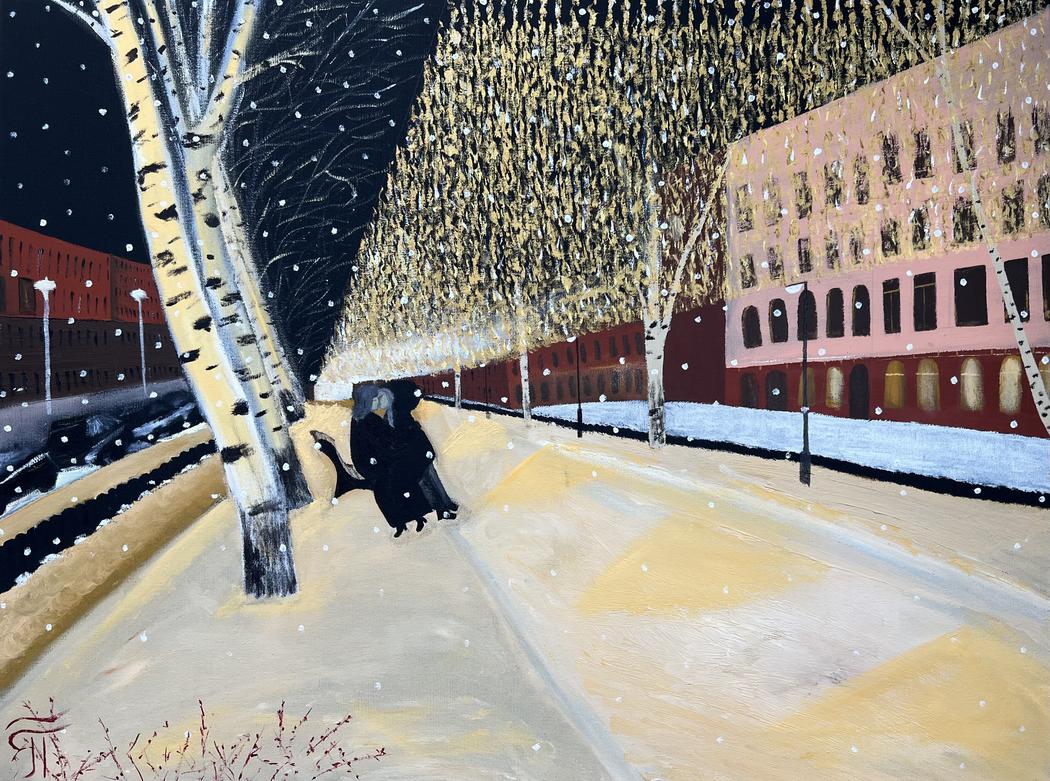Galina Tuzikova
Your education: Higher education with qualifications as a lawyer, economist, bankruptcy trustee, appraiser, Spanish language teacher, art historian, and artist.
Describe your art in three words: naïve · decorative primitivism · realisma
Your discipline: No specific specialization — I paint what I like.
 Galina Tuzikova | We are with Kolyan on Kirov Street in Kemerovo (or I remember your fur hat and leather jacket) | 2025
Galina Tuzikova | We are with Kolyan on Kirov Street in Kemerovo (or I remember your fur hat and leather jacket) | 2025
Your painting captures a deeply personal moment from your youth. How did it feel to return to this memory on canvas, and did you discover something new about that time while painting it?
You know, when I paint, I always feel joy. At the same time, creating a work about my youth and my hometown evoked special emotions, as if I had returned to that time when happiness overflowed and everything felt too much and over the top. All doors were open and all roads awaited us. Back then, time felt very unstable, it flowed like the melting clocks in Salvador Dalí’s painting, and there was enough of it for so many things! Yes, every stage of life has its joys, but that time was truly magical, because the greatest potential lies precisely at the beginning.
You described the scene as “retro,” yet it feels timeless. How do you balance a sense of personal nostalgia with universal emotions in your art?
I think it’s all about time again: it lasts forever, and what happened to me yesterday may have happened to someone else the day before, today, or may happen tomorrow. Each of us is part of this world, so the story of a man and a woman is an endless, eternal story understood by every person.
Light and color are striking in this piece — the golden illumination of the garlands and the soft winter palette. Could you talk about your approach to conveying atmosphere and mood?
Before starting each work, I ask for help from the saints (our family is Orthodox Christian). Of course, I plan the details, the arrangement of the characters, and the palette. But the secret is that at some point the painting begins to live its own life, as if it shows how things should be. And I realize that my initial plan has changed significantly — and that’s good. Therefore, I cannot define or describe an exact algorithm for creating the atmosphere and mood.
The title mentions your husband’s “sable hat and leather jacket.” What do these details mean to you, and how do they enrich the storytelling of the painting?
Indeed, these details are a feature of that time; many people wore such things, and I also had a sable hat and a leather jacket. But my husband’s hat and jacket were not particularly fashionable; rather, he had to wear them. Those were not easy times for his family, and he needed to dress warmly because Kemerovo is in Siberia, where winters are quite cold. However, such conditions — unfashionable clothing and cold weather — could not overshadow the joy of our meetings or shake our belief in a happy future together.
Your works have been exhibited internationally. How do audiences abroad respond to such intimate, family-centered subjects?
Viewers respond very warmly to these subjects. I am very happy that people everywhere in the world generally respect family values. Our family loves to travel, just like many others. We enjoy seeking authenticity, communicating with different people in the countries we visit, and learning about their culture and daily life. We like to rent a car and travel the roads of a new country. And wherever we have been, we have seen that the greatest value for most people is their loved ones, family well-being, and mutual understanding.
How does being both a professional artist and an art historian influence your creative process and interpretation of your own work?
I don’t know how to answer this question exactly. Perhaps an art historian can be critical of an artist’s work. But you know, sometimes the secret of perfection lies in imperfection. What some see as a flaw, others perceive as a charming feature. It’s like with the people we love. We know that in some ways they are not always perfect, yet in our eyes they remain the most beloved. And I love all my works very much.
Family life is central in your biography. How do your husband and three children inspire or participate in your artistic journey?
Yes, that’s true: family plays an important role in my life. My husband and children are the main admirers of my work. First of all, they have to be: every free space in our homes is filled and decorated with my works. Secondly, there are pieces that I created on the request of my husband and children. And without my husband’s support, I might never have exhibited my works anywhere and would have continued to paint just for myself. He believes in my abilities more than I do. In addition, my family is a source of inspiration. I gladly paint my children and my husband. I have a painting depicting my husband and sons on a beach during a trip to Mexico. As it happened, in an international competition that took place in Mexico, this painting won third place.

Leave a Reply